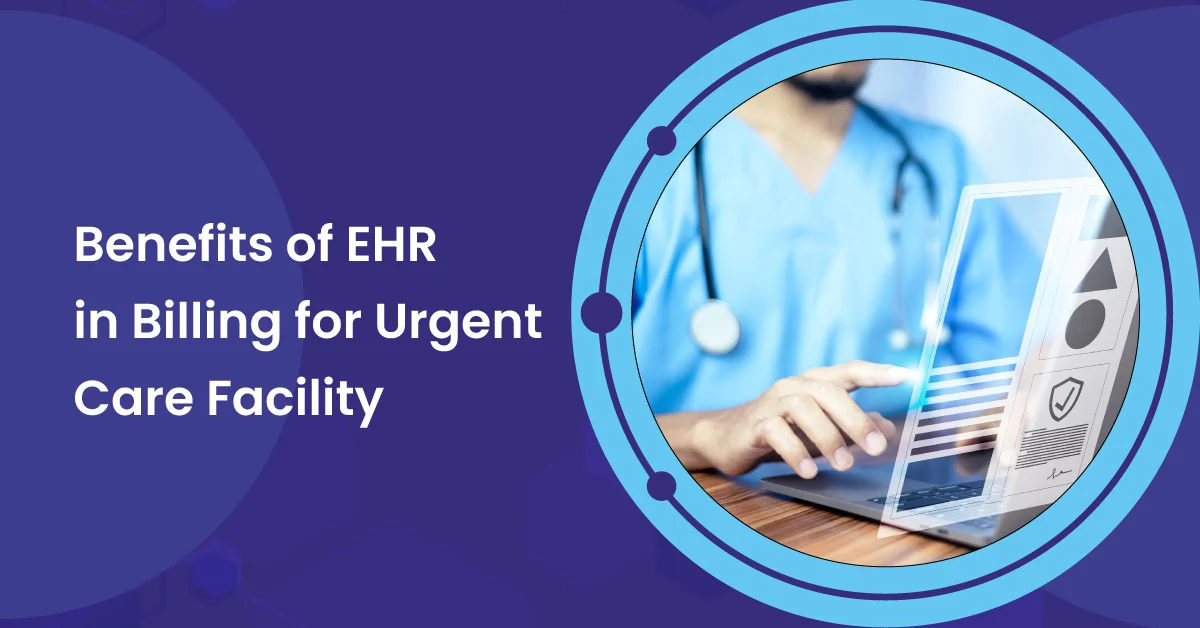Electronic Health Records (EHRs) are electronic versions of a patient’s paper medical records. They keep track of the person’s medical history, diagnoses, medications, treatment plans, dates of vaccines, allergies, radiology images, and the results of lab and test findings.
EHRs are super helpful tools for urgent care providers as well. They make billing easier by doing things automatically like generating invoices and processing payments. This automation means fewer mistakes and better communication with the people who pay the bills. It also helps urgent care providers get paid faster, which means smooth cash flow as well.
In this blog post, we’ll look at how using EHRs in urgent care can optimize billing process workflows and increase the revenue cycle’s overall effectiveness.
Market Analysis of EHRs in the Healthcare Sector
Government programs, tech developments, and centralization/digitization drive EHR market growth. Here is a market analysis of Electronic Health Records (EHRs) in the healthcare industry:
- The global EHR market size is expected to reach $39.9 billion by 2026, growing at a CAGR of 5.4% from 2019 to 2026.
- The global electronic health records market is expected to grow from $30.55 billion in 2020 to $63.85 billion by 2030, at a CAGR of 7.7%.
Steps in Urgent Care Billing Process
The EHR is used throughout the billing process in urgent care facilities. It tracks patient info, documents provider notes, and submits bills to insurance.
- The patient checks in at the urgent care facility and provides their insurance information.
- The provider enters the patient’s information into the EHR, including their symptoms, medical history, and medications.
- The provider performs a physical exam and orders any necessary tests.
- The provider diagnoses the patient and recommends a treatment plan.
- The provider enters the diagnosis and treatment plan into the EHR.
- The provider submits the bill to the patient’s insurance company.
- The insurance company reviews the bill and approves or denies payment.
- If the insurance company approves payment, the urgent care facility sends the patient a bill for the copay or coinsurance amount.
- If the insurance company denies payment, the urgent care facility may appeal the decision.
EHRs in Urgent Care Billing Management
Today, urgent care facilities are essential.
As the need for primary care physicians grows, more and more people are going to urgent care clinics for their necessary medical requirements.
Urgent care clinics need a system to quickly provide diagnostic and treatment options, and keep records for easy access.
For this purpose, an ideal electronic health record system is a tool for urgent care.
EHRs allow authorized individuals to update patient records in real-time and access them digitally. The records include data on the patient’s medical history, allergy details, imaging results, laboratory results, a list of drugs, treatment strategies, and progress remarks.
Additionally, they give medical professionals the resources they need to decide on a patient’s medical care after doing their research. These resources could be things like medical literature, research papers, guidelines from professional medical associations, and even data from other patients with similar conditions.
So, with all this valuable info at their fingertips, doctors can make well-informed decisions about how to take care of their patients best.
Do you know? The ACA has made EHR software essential for healthcare delivery. 95% of qualified hospitals have successfully implemented EHRs since 2016.
Benefits of EHR System in Urgent Care Facilities
EHRs, like Medifusion, streamline urgent care billing by automating, standardizing, and centralizing data.
➜ Automating: When EHRs automate billing, they do many tasks automatically, so people don’t have to do them by hand. This saves time and reduces errors. For example, creating invoices, calculating charges, and sending bills are all done by the EHR system without urgent care providers doing it manually.
➜ Standardizing: Standardizing data in EHRs means organizing information in a consistent and uniform way. Patient details and billing codes follow the same format and rules. It helps everyone understand the information easily and makes billing processing simpler.
➜ Centralizing: Centralizing data in EHRs means storing all important billing information in one central place, like a digital database. No more scattered paper records or different systems. Now, all billing data is in one location, making it convenient for urgent care providers to manage and track their billing operations efficiently.
Let’s explore in more detail how EHRs improve urgent care billing workflows:
Improves Data Accuracy
Manual tasks and human errors cause inaccuracy in patient data, diagnosis codes, and treatment details. Electronic health records (EHR) systems automate the process of data entry, reducing the risk of human error. This ensures that patient data, diagnosis codes, treatment details, and other vital information are stored accurately and can be easily retrieved, which helps ensure accurate billing.
Enhances Data Privacy and Security
Despite the secure protocols, the risk of data breaches still exists in digital systems. EHRs safeguard sensitive patient information, aligning with HIPAA regulations. Moreover, these digital systems ensure data integrity by maintaining the accuracy and consistency of data over its entire lifecycle.
Enables Efficient Data Transfer
Data sharing between different medical systems may be problematic. EHRs enable seamless data transfer between departments, from care providers to billing specialists and healthcare providers to insurance companies. This streamlined data transfer expedites the billing process, reducing delays and improving the revenue cycle.
Integrates Medical Coding System
The complexity of coding systems makes it difficult to understand and apply the correct codes. EHR systems can be integrated with medical coding systems like ICD-10, allowing for direct coding from the patient’s record. This reduces coding errors and speeds up the billing process. EHRs can also alert providers to changes or updates in coding regulations.
Updates Data in Real-Time
Real-time data access is the need of the hour for urgent care to streamline their billing process. EHRs enable real-time updates to patient records, ensuring the most recent and relevant information is available to everyone involved in the care and billing process. This feature aids in accurate claim submissions and quicker reimbursements.
Ensures Enhanced Regulatory Compliance
Regulatory compliance is another major challenge for urgent care due to constantly changing healthcare regulations. EHR systems are designed to meet regulatory standards and can be updated to adapt to changes in healthcare regulations. They have in-built features to ensure compliance with HIPAA, MACRA, and other healthcare standards, making regulatory compliance more manageable.
Facilitates Improved Communication
Poor communication with patients and providers can interrupt the whole process affecting the seamless patient experience. TheEHRs foster improved communication between healthcare providers, patients, and insurance providers. Clear, comprehensive, and immediate information sharing can significantly enhance claim submissions and approvals, improving patient experiences and financial performance.
Empowers Robust Data Analytics and Reporting
Making decisions based on authentic reports and data is essential for the progress of urgent care. EHRs offer robust data analytics capabilities that provide valuable billing process insights. Reporting tools can track key metrics like claim denial rates, reimbursement rates, and time to payment, which can help urgent care centers optimize their revenue cycle management.
Drives Increased Financial Growth and Stability
The main objective for urgent care, no doubt, is to generate reasonable revenue. By reducing billing errors, improving the speed of the billing cycle, and enabling better claim management, EHRs can lead to more reliable and predictable cash flow. This stability can contribute to the financial growth of the urgent care center.
The Future of Electronic Health Record Systems
The current craze in healthcare is called “participatory,” and it involves patients working with their doctors to make decisions about their care and progress. EHRs are critical in improving patient outcomes and providing the entire healthcare system advantages.
It’s essential to take note of the following future trends in electronic health records (EHRs):
- Healthcare providers will use faster techniques for adoption to save expenses and money.
- EHR processing times will decrease significantly, allowing uninterrupted access to all required client services. Additionally, this will result in improved feedback in the risk and return groups.
- Greater interoperability will be made possible by more app extensions, which will also speed up the implementation of standalone solutions that may be included in EHR-based systems.
- EHR platforms will gradually develop into comprehensive digital health platforms. They’ll let people have customized experiences.
- Voice assist, and language processing will speed up record entry and searches.
- Patient care will be improved by making it easier to obtain information and see patients more quickly, improving patient data accuracy and reducing errors. Healthcare practitioners can make decisions more quickly and effectively because of interoperability.
- Telehealth platforms and EHRs can work together to introduce services and manage or track records.
- Improved visualization of the patient’s medical history and more user-friendly interfaces will enhance patient care mechanisms.
- Chatbots may also be implemented into these systems.
Final Thoughts
Electronic medical records have become a game-changing technology in the healthcare sector. It is essential for urgent care clinicians because it can improve workflows, patient experiences, and teamwork.
They guarantee data privacy while improving efficiency, accuracy, and regulatory compliance. EHRs result in accurate, rapid billing and quick claim payments by reducing complex medical coding and enabling smooth data transfer.
Additionally, they offer strong analytics capabilities that support strategic decision-making. EHR technology in the billing procedure is anticipated to optimize urgent care services as the technology develops significantly. EHRs have improved the efficiency and dependability of urgent care billing procedures.





